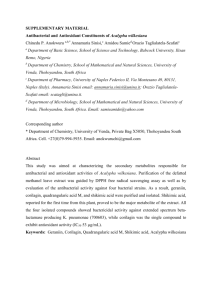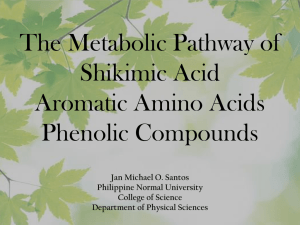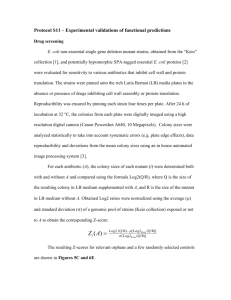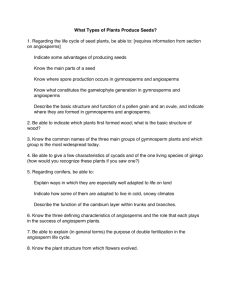Prospecting for alternate sources of shikimic acid, a precursor of
advertisement
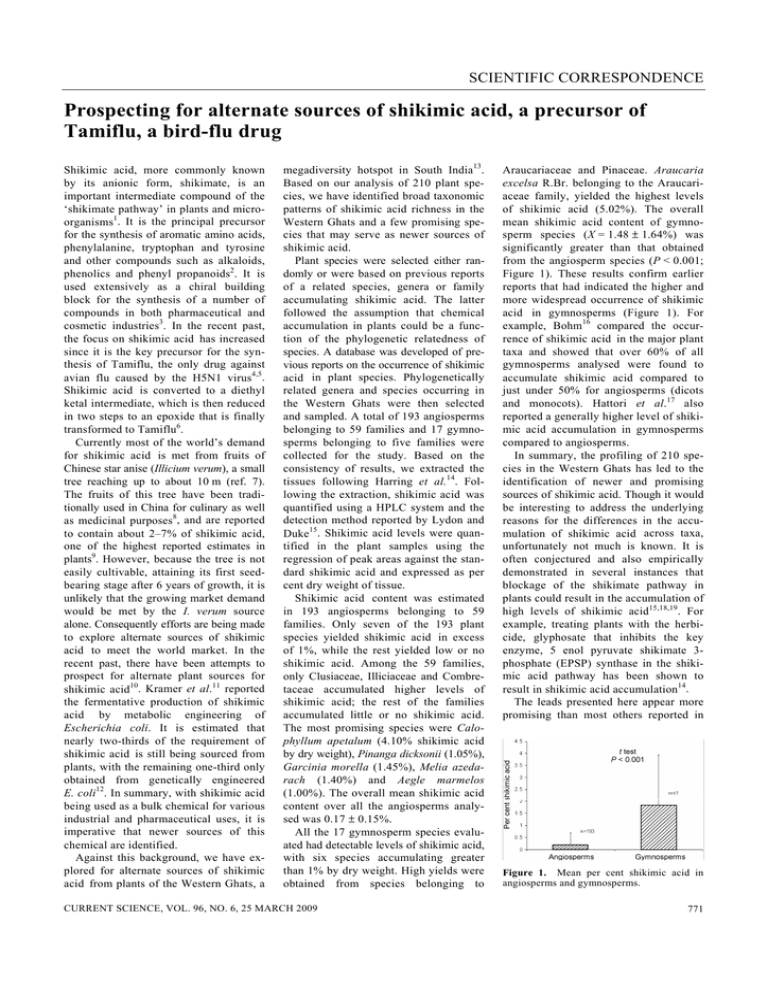
SCIENTIFIC CORRESPONDENCE Prospecting for alternate sources of shikimic acid, a precursor of Tamiflu, a bird-flu drug Shikimic acid, more commonly known by its anionic form, shikimate, is an important intermediate compound of the ‘shikimate pathway’ in plants and microorganisms1. It is the principal precursor for the synthesis of aromatic amino acids, phenylalanine, tryptophan and tyrosine and other compounds such as alkaloids, phenolics and phenyl propanoids2. It is used extensively as a chiral building block for the synthesis of a number of compounds in both pharmaceutical and cosmetic industries3. In the recent past, the focus on shikimic acid has increased since it is the key precursor for the synthesis of Tamiflu, the only drug against avian flu caused by the H5N1 virus4,5. Shikimic acid is converted to a diethyl ketal intermediate, which is then reduced in two steps to an epoxide that is finally transformed to Tamiflu6. Currently most of the world’s demand for shikimic acid is met from fruits of Chinese star anise (Illicium verum), a small tree reaching up to about 10 m (ref. 7). The fruits of this tree have been traditionally used in China for culinary as well as medicinal purposes8, and are reported to contain about 2–7% of shikimic acid, one of the highest reported estimates in plants9. However, because the tree is not easily cultivable, attaining its first seedbearing stage after 6 years of growth, it is unlikely that the growing market demand would be met by the I. verum source alone. Consequently efforts are being made to explore alternate sources of shikimic acid to meet the world market. In the recent past, there have been attempts to prospect for alternate plant sources for shikimic acid10. Kramer et al.11 reported the fermentative production of shikimic acid by metabolic engineering of Escherichia coli. It is estimated that nearly two-thirds of the requirement of shikimic acid is still being sourced from plants, with the remaining one-third only obtained from genetically engineered E. coli12. In summary, with shikimic acid being used as a bulk chemical for various industrial and pharmaceutical uses, it is imperative that newer sources of this chemical are identified. Against this background, we have explored for alternate sources of shikimic acid from plants of the Western Ghats, a megadiversity hotspot in South India13. Based on our analysis of 210 plant species, we have identified broad taxonomic patterns of shikimic acid richness in the Western Ghats and a few promising species that may serve as newer sources of shikimic acid. Plant species were selected either randomly or were based on previous reports of a related species, genera or family accumulating shikimic acid. The latter followed the assumption that chemical accumulation in plants could be a function of the phylogenetic relatedness of species. A database was developed of previous reports on the occurrence of shikimic acid in plant species. Phylogenetically related genera and species occurring in the Western Ghats were then selected and sampled. A total of 193 angiosperms belonging to 59 families and 17 gymnosperms belonging to five families were collected for the study. Based on the consistency of results, we extracted the tissues following Harring et al.14. Following the extraction, shikimic acid was quantified using a HPLC system and the detection method reported by Lydon and Duke15. Shikimic acid levels were quantified in the plant samples using the regression of peak areas against the standard shikimic acid and expressed as per cent dry weight of tissue. Shikimic acid content was estimated in 193 angiosperms belonging to 59 families. Only seven of the 193 plant species yielded shikimic acid in excess of 1%, while the rest yielded low or no shikimic acid. Among the 59 families, only Clusiaceae, Illiciaceae and Combretaceae accumulated higher levels of shikimic acid; the rest of the families accumulated little or no shikimic acid. The most promising species were Calophyllum apetalum (4.10% shikimic acid by dry weight), Pinanga dicksonii (1.05%), Garcinia morella (1.45%), Melia azedarach (1.40%) and Aegle marmelos (1.00%). The overall mean shikimic acid content over all the angiosperms analysed was 0.17 ± 0.15%. All the 17 gymnosperm species evaluated had detectable levels of shikimic acid, with six species accumulating greater than 1% by dry weight. High yields were obtained from species belonging to CURRENT SCIENCE, VOL. 96, NO. 6, 25 MARCH 2009 Araucariaceae and Pinaceae. Araucaria excelsa R.Br. belonging to the Araucariaceae family, yielded the highest levels of shikimic acid (5.02%). The overall mean shikimic acid content of gymnosperm species (X = 1.48 ± 1.64%) was significantly greater than that obtained from the angiosperm species (P < 0.001; Figure 1). These results confirm earlier reports that had indicated the higher and more widespread occurrence of shikimic acid in gymnosperms (Figure 1). For example, Bohm16 compared the occurrence of shikimic acid in the major plant taxa and showed that over 60% of all gymnosperms analysed were found to accumulate shikimic acid compared to just under 50% for angiosperms (dicots and monocots). Hattori et al.17 also reported a generally higher level of shikimic acid accumulation in gymnosperms compared to angiosperms. In summary, the profiling of 210 species in the Western Ghats has led to the identification of newer and promising sources of shikimic acid. Though it would be interesting to address the underlying reasons for the differences in the accumulation of shikimic acid across taxa, unfortunately not much is known. It is often conjectured and also empirically demonstrated in several instances that blockage of the shikimate pathway in plants could result in the accumulation of high levels of shikimic acid15,18,19. For example, treating plants with the herbicide, glyphosate that inhibits the key enzyme, 5 enol pyruvate shikimate 3phosphate (EPSP) synthase in the shikimic acid pathway has been shown to result in shikimic acid accumulation14. The leads presented here appear more promising than most others reported in Figure 1. Mean per cent shikimic acid in angiosperms and gymnosperms. 771 SCIENTIFIC CORRESPONDENCE the literature2,10,20. Further, in a few of these species, the estimates are comparable to those reported for star anise2 (2.4– 7%). However, one of the most significant advantages of the newly identified Indian sources is that the estimates are from leaves and not fruits as is the case with star anise. Quite obviously, extraction from leaves will be preferred over that from fruits; moreover, the sheer volume of the biomass offered by the leaves would render it economically feasible. In other words, the finding of the new sources of shikimic acid can potentially be used to meet the emerging needs of both the domestic and the international market. 1. Gibson, M. I., Gibson, F., Doy, C. H. and Morgan, P. N., Nature, 1962, 195, 1173. 2. Payne, R. and Edmonds, M., J. Chem. Edu. (Suppl.), 2005, 82, 599–600. 3. Tiedtke, J., Cosmet. Sci. Technol., 2006, 15–21. 4. Uma Shaanker, R., Curr. Sci., 2006, 90, 1585–1586. 5. Singer, A. C., Nunn, M. A., Gould, E. A. and Johnson, A. C., Environ. Health Perspect., 2007, 115, 102–106. 6. Yarnell, A., Chem. Eng. News, 2005, 83, 22–23. 7. Wendy, A., The Identification of Medicinal Plants. A Handbook of the Morphology of Botanicals in Commerce, Missouri Botanical Garden Press, 2006, p. 89. 8. Ortiz, B. I. and Clauson, K. A., J. Am. Pharm. Assoc., 2006, 46, 161–167. 9. Adams, H. et al., Tetrahedron, 1996, 52, 8565–8580. 10. Enrich, L. B. et al., Tetrahedron Lett., 2008, 49, 2503–2505. 11. Kramer, M. et al., Metab. Eng, 2003, 5, 277–283. 12. Frantz, S., Nature Rev. Drug Discovery, 2006, 5, 7–9. 13. Myers, N., Mittermeir, R. A., da Fonseca, G. A. B. and Kent, J., Nature, 2000, 403, 853–857. 14. Harring, T., Streibig, J. C. and Husted, S., J. Agric. Food. Chem., 1998, 46, 4406–4412. 15. Lydon, J. and Duke, O. S., J. Agric. Food Chem., 1988, 36, 813–818. 16. Bohm, B. A., Chem. Rev., 1965, 65, 435– 466. 17. Hattori, S., Yoshida, S. and Hasegawa, M., Physiol. Plant, 1954, 7, 283–289. 18. Amrhein, N., Deus, B., Gehrke, P. and Steinrucken, H. C., Plant Physiol., 1980, 66, 830–834. 19. Berlin, J. and Witte, L., Z. Naturforsch. C, 1981, 36, 210–214. 20. Hudina, M. and Stampar, F., Acta Agricul. Slov., 2005, 85, 179–185. ACKNOWLEDGEMENTS. The work was supported by grants from the Department of Biotechnology, New Delhi. Field collection of plants from the Western Ghats was facilitated by the kind permission of the State Forest Department, Government of Karnataka. B.T.R., G.R. and T.R.R. were involved in sample collection. Extraction and chemical analysis was performed by P.V., H.K.S. and T.R.R. Data analysis was done by B.T.R., R.U.S., A.S. and K.N.G. supervised the work. R.U.S. and P.V. wrote the paper. Received 25 November 2008; revised accepted 9 February 2009 T. R. RAGHAVENDRA1,2 PRITI VAIDYANATHAN1,4 H. K. SWATHI1 B. T. RAMESHA1,2 G. RAVIKANTH1,4 K. N. GANESHAIAH1,3,4 A. SRIKRISHNA5 R. UMA SHAANKER1,2,4,* 1 School of Ecology and Conservation, Department of Crop Physiology and 3 Department of Forestry and Environmental Sciences, University of Agricultural Sciences, GKVK Campus, Bangalore 560 065, India 4 Suri Sehgal Centre for Conservation Science, Ashoka Trust for Research in Ecology and the Environment, Royal Enclave, Srirampura, Jakkur Post, Bangalore 560 064, India 5 Department of Organic Chemistry, Indian Institute of Science, Bangalore 560 012, India *For correspondence. e-mail: umashaanker@gmail.com 2 Anti-predator behaviour of Large brown flying squirrel (Petaurista philippensis): is this an effective census method to survey the species? Density or relative abundance of wild animals over space and time is a prerequisite for evolving effective management strategies. Such population estimates of nocturnal mammals have been hard to obtain and are often prohibitively expensive. Acoustic lures are extensively employed in ornithology to elicit response from the focal bird and later this has been adopted as a census method for the elusive and secretive animals1,2. Call playbacks of conspecifics are used mostly for passerines as well as for nonpasserines like nocturnal and diurnal raptors3–6 and in secretive water birds7. Interspecific and potential predator calls 772 have also been employed to increase the detection rate of diurnal raptors of the woodland forest3. Similarly, call playback experiments were used to develop various theories of animal behaviour (neighbour and stranger discrimination). We employed the call playback of conspecific owl calls to enhance the detection rate of owls in the preselected census points. In the reconnaissance survey, the Large brown flying squirrel (Petaurista philippensis) was observed to respond to the owl’s calls and such response or alarm calls of flying squirrels were recorded. In earlier studies, spotlight search over the pre-established trail was the common method employed to encounter flying squirrels in the Western Ghats8–10. Some reports on gliding mammals revealed that they respond to the predator’s approach11. Rohner12 recorded the anti-predator response of Eurasian Red squirrels (Sciurus vulgaris) to predator calls of the Tawny owl. Since call playback method has not been employed to census nocturnal mammals, we report our observations using this technique. Out of the two species of flying squirrels found in the southern Western Ghats (Large brown flying squirrel and Small Travancore flying squirrel), we selected the Large brown flying squirrel due to its CURRENT SCIENCE, VOL. 96, NO. 6, 25 MARCH 2009
